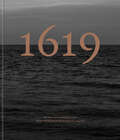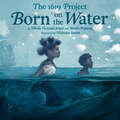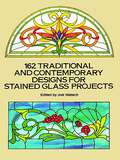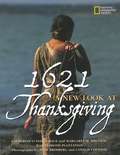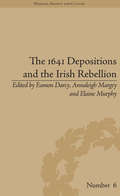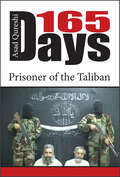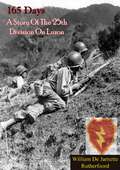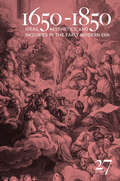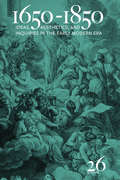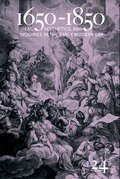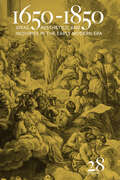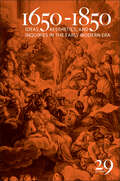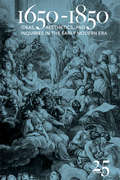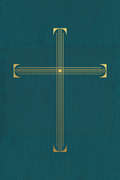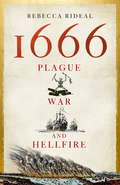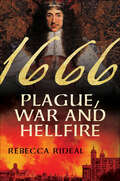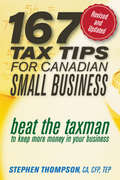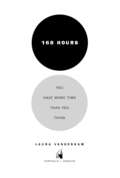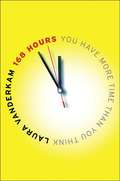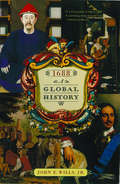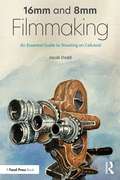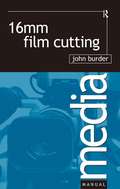- Table View
- List View
The 1619 Project: A Visual Experience
by Nikole Hannah-Jones The New York Times MagazineAn illustrated edition of The 1619 Project, with newly commissioned artwork and archival images, The New York Times Magazine&’s award-winning reframing of the American founding and its contemporary echoes, placing slavery and resistance at the center of the American story.Here, in these pages, Black art provides refuge. The marriage of beautiful, haunting and profound words and imagery creates an experience for the reader, a wanting to reflect, to sit in both the discomfort and the joy, to contemplate what a nation owes a people who have contributed so much and yet received so little, and maybe even, to act.—Nikole Hannah-Jones, from the PrefaceCurated by the editors of The New York Times Magazine, led by Pulitzer Prize–winning journalist Nikole Hannah-Jones, this illustrated edition of The 1619 Project features seven chapters from the original book that lend themselves to beautiful, engaging visuals, deepening the experience of the content. The 1619 Project: A Visual Experience offers the same revolutionary idea as the original book, an argument for a new national origin story that begins in late August of 1619, when a cargo ship of people stolen from Africa arrived on the shores of Point Comfort, Virginia. Only by reckoning with this difficult history and understanding its powerful influence on our present can we prepare ourselves for a more just future. Filled with original art by thirteen Black artists like Carrie Mae Weems, Calida Rawles, Vitus Shell, Xaviera Simmons, on the themes of resistance and freedom, a brand-new photo essay about slave auction sites, vivid photos of Black Americans celebrating their own forms of patriotism, and a collection of archival images of Black families by Black photographers, this gorgeous volume offers readers a dynamic new way of experiencing the impact of The 1619 Project.Complete with many of the powerful essays and vignettes from the original edition, written by some of the most brilliant journalists, scholars, and thinkers of our time, The 1619 Project: A Visual Experience brings to life a fuller, more comprehensive understanding of American history and culture.
The 1619 Project: Born on the Water
by Nikole Hannah-Jones Renée WatsonThe 1619 Project&’s lyrical picture book in verse chronicles the consequences of slavery and the history of Black resistance in the United States, thoughtfully rendered by Pulitzer Prize-winning journalist Nikole Hannah-Jones and Newbery honor-winning author Renée Watson. A young student receives a family tree assignment in school, but she can only trace back three generations. Grandma gathers the whole family, and the student learns that 400 years ago, in 1619, their ancestors were stolen and brought to America by white slave traders. But before that, they had a home, a land, a language. She learns how the people said to be born on the water survived. And the people planted dreams and hope,willed themselves to keepliving, living. And the people learned new wordsfor lovefor friendfor family for joyfor growfor home. With powerful verse and striking illustrations by Nikkolas Smith, Born on the Water provides a pathway for readers of all ages to reflect on the origins of American identity.
162 Traditional and Contemporary Designs for Stained Glass Projects
by Joel WallachFor centuries, elegant and beautiful stained glass has enhanced churches, homes and other buildings. Its popularity continues today as increasing numbers of homeowners, interior designers, and craftspeople turn to this attractive form of decoration. Now stained glass workers can have a treasury of attractive, usable designs at their fingertips, ready for use in almost any stained glass projects. This collection includes over 160 patterns -- in both traditional and contemporary styles -- all easily adaptable as templates for stained glass work. Landscapes, geometric shapes, florals, and birds are among the wealth of motifs presented. What's more, the designs come in a wide variety of sizes and shapes, making them ideal as patterns for windows, mirrors, panels, sidelights, and other stained glass configurations. Immediately usable and royalty-free, these designs also lend themselves to a broad range of other art and craft projects.
1621: A New Look At Thanksgiving
by Cotton Coulson Sisse Brimberg Margaret M. Bruchac Catherine O'Neill Grace Plimoth PlantationIn cooperation with the Plimoth Plantation, a living-history museum in Massachusetts, National Geographic has recreated the first Thanksgiving. Photographs by National Geographic photographers of the recreation at Plimoth Plantation illustrate this book. In 1621, in a small settlement on the edge of the sea, 52 English colonists celebrated their first harvest. The colonists were joined by 90 men of the Wampanoag tribe for a gathering that was to last three days in a town now known as Plymouth. Over the centuries, there have been countless versions of this story, creating a popular myth of the first Thanksgiving. Many Americans imagine brave, peaceful settlers inviting a few wild Indians over for a turkey dinner. But there was no pumpkin pie or cranberry sauce at this celebration. There were no Indians with woven blankets over their shoulders and large feathered headdresses. No pilgrims with somber black clothes and silver buckle hats either. The English didn't even call themselves Pilgrims. This book puts aside that myth and takes a new look at our American history. It questions what we know and recovers lost voices of the Wampanoag people. True history includes the voices of all its participants. 1621: A New Look at Thanksgiving invites young people to read, listen, and think about our shared history. The book also features a foreword, a section on the actual reenactment and the concept of living history, a chronology, an index, and a bibliography.
The 1641 Depositions and the Irish Rebellion (Warfare, Society and Culture #6)
by Eamon Darcy Annaleigh Margey Elaine MurphyThe 1641 Depositions are among the most important documents relating to early modern Irish history. This essay collection is part of a major project run by Trinity College, Dublin, using the depositions to investigate the life and culture of seventeenth-century Ireland.
165 Days: Prisoner of the Taliban
by Asad QureshiA gripping first-person account of long-term captivity at the hands of terrorists in Waziristan, the dangerous border region between Pakistan and Afghanistan. While Asad was held hostage, his family struggled mightily to free him. This book highlights not only the will to survive, but also the love of family.There are several popular accounts of Taliban hostages who were rescued by American Special Forces; Asad was handed over to and escorted home by operatives of Al Qaeda.
165 Days: A Story Of The 25th Division On Luzon
by William De Jarnette Rutherford165 Days: A Story Of The 25th Division On Luzon by William De Jarnette Rutherfoord is a gripping and meticulously illustrated account of the 25th Infantry Division's pivotal role in the liberation of Luzon during World War II. Through vivid storytelling and firsthand accounts, Rutherfoord brings to life the harrowing experiences, intense battles, and unwavering determination of the soldiers who fought to reclaim the Philippines from Japanese occupation.The book covers the 165 days of relentless combat that defined the 25th Division’s campaign on Luzon, the largest and most strategically significant island in the Philippines. Rutherfoord, a member of the division, provides an insider's perspective on the brutal realities of jungle warfare, the challenges of supply and communication, and the indomitable spirit of the soldiers who faced overwhelming odds in their mission to secure victory.165 Days offers readers a detailed chronicle of the division’s maneuvers, from the initial landings to the final push that led to the liberation of Manila and the collapse of Japanese resistance. Rutherfoord captures the camaraderie, bravery, and sacrifices of the men in the division, highlighting both the human cost of war and the resilience of those who served.The book also delves into the strategic importance of the Luzon campaign, explaining how the actions of the 25th Division contributed to the broader Allied effort to defeat Japan in the Pacific Theater. Maps, photographs, and other illustrations complement the narrative, providing a comprehensive understanding of the terrain, tactics, and experiences of the soldiers.165 Days: A Story Of The 25th Division On Luzon is an essential read for military historians, veterans, and anyone interested in the Pacific War. William De Jarnette Rutherfoord’s compelling narrative honors the legacy of the 25th Infantry Division, offering a powerful testament to the courage and dedication of the men who fought to liberate the Philippines.This book stands as a tribute to the enduring spirit of the 25th Division, ensuring that the story of their sacrifice and triumph will never be forgotten.
1650-1850: Ideas, Aesthetics, and Inquiries in the Early Modern Era (Volume 27) (1650-1850 #27)
by Chris Barrett Mita Choudhury Matthew Goldmark Jennifer L. Hargrave Betty Joseph Billie Lythberg David Mazella Su Fang Ng Felicity Nussbaum Daniel O'Quinn Elizabeth Sauer Ana Schwartz Brandie Siegfried Daniel Vitkus Lisa Walters Chi-Ming Yang Andrew Black Samara Anne Cahill Erica Johnson Edwards James Hamby Stephanie Howard-Smith Anthony W. Lee Daniel Livesay Seow-Chin Ong Linda L. Reesman Gefen Bar-On Santor Jacqy SharpeRigorously inventive and revelatory in its adventurousness, 1650–1850 opens a forum for the discussion, investigation, and analysis of the full range of long-eighteenth-century writing, thinking, and artistry. Combining fresh considerations of prominent authors and artists with searches for overlooked or offbeat elements of the Enlightenment legacy, 1650–1850 delivers a comprehensive but richly detailed rendering of the first days, the first principles, and the first efforts of modern culture. Its pages open to the works of all nations and language traditions, providing a truly global picture of a period that routinely shattered boundaries. Volume 27 of this long-running journal is no exception to this tradition of focused inclusivity. Readers will travel through a blockbuster special feature on the topic of worldmaking and other worlds—on the Enlightenment zest for the discovery, charting, imagining, and evaluating of new worlds, envisioned worlds, utopian worlds, and worlds of the future. Essays in this enthusiastically extraterritorial offering escort readers through the science-fictional worlds of Lady Cavendish, around European gardens, over the high seas, across the American frontiers, into forests and exotic ecosystems, and, in sum, into the unlimited expanses of the Enlightenment mind. Further enlivening the volume is a cavalcade of full-length book reviews evaluating the latest in eighteenth-century scholarship.
1650-1850: Ideas, Aesthetics, and Inquiries in the Early Modern Era (Volume 26) (1650-1850 #26)
by Norbert Col Andrew Connell Taylor Corse Matthew Davis Michael Edson Melvyn New Mark A. Pedreira Linda L. Reesman Adam Rounce Robin Runia Jacob Sider Jost Gefen Bar-On Santor Ashley Bender John Burke Greg Clingham Gloria Eive Sören Hammerschmidt Malcolm Jack Christopher Johnson Robin Mills John Sitter Paul DeGategnoVolume 26 of 1650–1850: Ideas, Aesthetics, and Inquiries in the Early Modern Era travels beyond the usual discussions of power, identity, and cultural production to visit the purlieus and provinces of Britain’s literary empire. Bulging at its bindings are essays investigating out-of-the-way but influential ensembles, whether female religious enthusiasts, annotators of Maria Edgeworth’s underappreciated works, or modern video-based Islamic super-heroines energized by Mary Wollstonecraft’s irreverance. The global impact of the local is celebrated in studies of the personal pronoun in Samuel Johnson’s political writings and of the outsize role of a difficult old codger in catalyzing the literary career of Charlotte Smith. Headlining a volume that peers into minute details in order to see the outer limits of Enlightenment culture is a special feature on metaphor in long-eighteenth-century poetry and criticism. Five interdisciplinary essays investigate the deep Enlightenment origins of a trope usually associated with the rise of Romanticism. Volume 26 culminates in a rich review section containing fourteen responses to current books on Enlightenment religion, science, literature, philosophy, political science, music, history, and art. About the annual journal 1650-1850 1650-1850 publishes essays and reviews from and about a wide range of academic disciplines: literature (both in English and other languages), philosophy, art history, history, religion, and science. Interdisciplinary in scope and approach, 1650-1850 emphasizes aesthetic manifestations and applications of ideas, and encourages studies that move between the arts and the sciences—between the “hard” and the “humane” disciplines. The editors encourage proposals for special features that bring together five to seven essays on focused themes within its historical range, from the Interregnum to the end of the first generation of Romantic writers. While also being open to more specialized or particular studies that match up with the general themes and goals of the journal, 1650-1850 is in the first instance a journal about the artful presentation of ideas that welcomes good writing from its contributors. ISSN 1065-3112. Published by Bucknell University Press. Distributed worldwide by Rutgers University Press.
1650-1850: Ideas, Aesthetics, and Inquiries in the Early Modern Era (Volume 24) (1650-1850 Ser. #Vol. 4)
by Kevin L. Cope1650-1850 publishes essays and reviews from and about a wide range of academic disciplines—literature (both in English and other languages), philosophy, art history, history, religion, and science. Interdisciplinary in scope and approach, 1650-1850 emphasizes aesthetic manifestations and applications of ideas, and encourages studies that move between the arts and the sciences—between the “hard” and the “humane” disciplines. The editors encourage proposals for “special features” that bring together five to seven essays on focused themes within its historical range, from the Interregnum to the end of the first generation of Romantic writers. While also being open to more specialized or particular studies that match up with the general themes and goals of the journal, 1650-1850 is in the first instance a journal about the artful presentation of ideas that welcomes good writing from its contributors. First published in 1994, 1650-1850 is currently in its 24th volume. ISSN 1065-3112. Published by Bucknell University Press. Distributed worldwide by Rutgers University Press.
1650-1850: Ideas, Aesthetics, and Inquiries in the Early Modern Era (Volume 28) (1650-1850 #28)
by Kevin L. CopeRigorously inventive and revelatory in its adventurousness, 1650–1850 opens a forum for the discussion, investigation, and analysis of the full range of long-eighteenth-century writing, thinking, and artistry. Combining fresh considerations of prominent authors and artists with searches for overlooked or offbeat elements of the Enlightenment legacy, 1650–1850 delivers a comprehensive but richly detailed rendering of the first days, the first principles, and the first efforts of modern culture. Its pages open to the works of all nations and language traditions, providing a truly global picture of a period that routinely shattered boundaries. Volume 28 of this long-running journal is no exception to this tradition of focused inclusivity. Readers will experience two blockbuster multi-author special features that explore both the deep traditions and the new frontiers of early modern studies: one that views adaptation and digitization through the lens of “Sterneana,” the vast literary and cultural legacy following on the writings of Laurence Sterne, a legacy that sweeps from Hungarian renditions of the puckish novelist through the Bloomsbury circle and on into cybernetics, and one that pays tribute to legendary scholar Irwin Primer by probing the always popular but also always challenging writings of that enigmatic poet-philosopher, Bernard Mandeville. All that, plus the usual cavalcade of full-length book reviews. ISSN: 1065-3112 Published by Bucknell University Press, distributed worldwide by Rutgers University Press.
1650-1850: Ideas, Aesthetics, and Inquiries in the Early Modern Era (Volume 29) (1650-1850 #29)
by Deborah Kennedy Greg Clingham Paul Tankard Christopher Johnson Susan Spencer Elizabeth Kraft Anthony W. Lee Ileana Baird Christina Ionescu Christopher Trigg Gefen Bar-On Santor John Knapp Paul DeGategno Jeanne M. Britton Angelina Dulong Mona Scheuermann Leigh D. Dillard Catherine J. Theobald Timothy Erwin Laurence Roussillon-Constanty Yanzhang Cui Duane Coltharp Thomas Hothem John C. Traver Courtney A. HoffmanExploratory, investigative, and energetically analytical, 1650–1850 covers the full expanse of long eighteenth-century thought, writing, and art while delivering abundant revelatory detail. Essays on well-known cultural figures combine with studies of emerging topics to unveil a vivid rendering of a dynamic period, simultaneously committed to singular genius and universal improvement. Welcoming research on all nations and language traditions, 1650–1850 invites readers into a truly global Enlightenment. Topics in volume 29 include Samuel Johnson’s notions about the education of women and a refreshing account of Sir Joseph Banks’s globetrotting. A guest-edited, illustration-rich, interdisciplinary special feature explores the cultural implications of water. As always, 1650–1850 culminates in a bevy of full-length book reviews critiquing the latest scholarship on long-established specialties, unusual subjects, and broad reevaluations of the period. ISSN 1065-3112 Published by Bucknell University Press, distributed worldwide by Rutgers University Press.
1650-1850: Ideas, Aesthetics, and Inquiries in the Early Modern Era (Volume 25) (1650-1850 Ser. #Vol. 4)
by Jack Lynch Howard Weinbrot Molly Marotta Yu Liu Anthony W Lee Claude Willan Daniel Gustafson James Horowitz Philip S. Palmer Pat Rogers Sarah Stein Samara Anne Cahill Suzanne L. Barnett R.J.W. Mills Nigel Penn Christopher Trigg Mark G. Spencer Roy Bogas Gefen Bar-On Santor Isabel Rivers Richard P. Heitzenrater Malcolm Jack Kate Brown Jane R. Stevens Robin Runia Paula Pinto Tamara WagnerVolume 25 of 1650–1850: Ideas, Aesthetics, and Inquiries in the Early Modern Era investigates the local textures that make up the whole cloth of the Enlightenment. Ranging from China to Cheltenham and from Spinoza to civil insurrection, volume 25 celebrates the emergence of long-eighteenth-century culture from particularities and prodigies. Unfurling in the folds of this volume is a special feature on playwright, critic, and literary theorist John Dennis. Edited by Claude Willan, the feature returns a major player in eighteenth-century literary culture to his proper role at the center of eighteenth-century politics, art, publishing, and dramaturgy. This celebration of John Dennis mingles with a full company of essays in the character of revealing case studies. Essays on a veritable world of topics—on Enlightenment philosophy in China; on riots as epitomes of Anglo-French relations; on domestic animals as observers; on gothic landscapes; and on prominent literati such as Jonathan Swift, Arthur Murphy, and Samuel Johnson—unveil eye-opening perspectives on a “long” century that prized diversity and that looked for transformative events anywhere, everywhere, all the time. Topping it all off is a full portfolio of reviews evaluating the best books on the literature, philosophy, and the arts of this abundant era. Published by Bucknell University Press. Distributed worldwide by Rutgers University Press.
The 1662 Book of Common Prayer: International Edition
by Samuel L. Bray Drew N. Keane, Samuel L. Bray Drew N. KeaneThe Book of Common Prayer (1662) is one of the most beloved liturgical texts in the Christian church, and remains a definitive expression of Anglican identity today. It is still widely used around the world, in public worship and private devotion, and is revered for both its linguistic and theological virtues. But the classic text of the 1662 prayer book presents several difficulties for contemporary users, especially those outside the Church of England. The 1662 Book of Common Prayer: International Edition gently updates the text for contemporary use. State prayers of England have been replaced with prayers that can be used regardless of nation or polity. Obscure words and phrases have been modestly revised—but always with a view towards preserving the prayer book's own cadence. Finally, a selection of treasured prayers from later Anglican tradition has been appended. The 1662 prayer book remains a vital resource today, both in the Anglican Communion and for Christians everywhere. Here it is presented for continued use for today's Christians throughout the world.
1666: Plague, War and Hellfire
by Rebecca Rideal1666 was a watershed year for England. The outbreak of the Great Plague, the eruption of the second Dutch War and the Great Fire of London all struck the country in rapid succession and with devastating repercussions.Shedding light on these dramatic events, historian Rebecca Rideal reveals an unprecedented period of terror and triumph. Based on original archival research and drawing on little-known sources, 1666: Plague, War and Hellfire takes readers on a thrilling journey through a crucial turning point in English history, as seen through the eyes of an extraordinary cast of historical characters. While the central events of this significant year were ones of devastation and defeat, 1666 also offers a glimpse of the incredible scientific and artistic progress being made at that time, from Isaac Newton's discovery of gravity to Robert Hooke's microscopic wonders. It was in this year that John Milton completed Paradise Lost, Frances Stewart posed for the now-iconic image of Britannia, and a young architect named Christopher Wren proposed a plan for a new London - a stone phoenix to rise from the charred ashes of the old city.With flair and style, 1666 shows a city and a country on the cusp of modernity, and a series of events that forever altered the course of history.
1666: Plague, War and Hellfire
by Rebecca Rideal1666 was a watershed year for England. The outbreak of the Great Plague, the eruption of the second Dutch War and the Great Fire of London all struck the country in rapid succession and with devastating repercussions.Shedding light on these dramatic events, historian Rebecca Rideal reveals an unprecedented period of terror and triumph. Based on original archival research and drawing on little-known sources, 1666: Plague, War and Hellfire takes readers on a thrilling journey through a crucial turning point in English history, as seen through the eyes of an extraordinary cast of historical characters. While the central events of this significant year were ones of devastation and defeat, 1666 also offers a glimpse of the incredible scientific and artistic progress being made at that time, from Isaac Newton's discovery of gravity to Robert Hooke's microscopic wonders. It was in this year that John Milton completed Paradise Lost, Frances Stewart posed for the now-iconic image of Britannia, and a young architect named Christopher Wren proposed a plan for a new London - a stone phoenix to rise from the charred ashes of the old city.With flair and style, 1666 shows a city and a country on the cusp of modernity, and a series of events that forever altered the course of history.
1666: Plague, War and Hellfire
by Rebecca Rideal1666 was a watershed year for England. An outbreak of the Great Plague, the eruption of the second Dutch War, and the devastating Great Fire of London all struck the country in rapid succession and with devastating repercussions.Shedding light on these dramatic events and their context, historian Rebecca Rideal reveals an unprecedented period of terror and triumph. Based in original archival research drawing on little-known sources, 1666 opens with the fiery destruction of London before taking readers on a thrilling journey through a crucial turning point in English history as seen through the eyes of an extraordinary cast of historical characters. While the central events of this significant year were ones of devastation and defeat, 1666 also offers a glimpse of the incredible scientific and artistic progress being made at that time, from Isaac Newton’s discovery of gravity to the establishment of The London Gazette. It was in this year that John Milton completed Paradise Lost, Frances Stewart posed for the iconic image of Britannia, and a young architect named Christopher Wren proposed a plan for a new London—a stone phoenix to rise from the charred ashes of the old city.With flair and style, 1666 exposes readers to a city and a country on the cusp of modernity and a series of events that altered the course of history.
167 Tax Tips for Canadian Small Business: Beat the Taxman to Keep More Money in Your Business
by Stephen Thompson"...a book for every Canadian in a small or home-based business who is struggling with complex tax rules and regulations." —Dale Ennis, Canadian MoneySaver "...easy-going style and avoidance of the more mind-numbing details make for a solid primer on the perks and pitfalls of self-employment. The...one-sentence tips in the appendix are probably worth the price of admission alone." —Gordon Powers, The Globe and Mail "...one of the better books I've seen on the market for small-business owners and better yet, it's all Canadian content." —Linda A. Fox, The Toronto Sun As a small-business owner or a home-based entrepreneur, you have lots of questions about taxes, but very few answers. Fortunately for you, 167 Tax Tips for Canadian Small Business contains a wealth of tax planning advice and strategies to help you save on your business tax bill. So whether you want to do it yourself or reduce what you pay your accountant - not to mention the government - this is how you'll keep more money in your pocket, where it belongs. Packed with tax tips that will save you hundreds, or even thousands, of dollars year-round. Written in a question-and-answer format that's easy to understand, practical, and easy to apply. Features 167 "Tax Beaters" - quick-reference tips that highlight key points - plus three bonus tips to help you save even more! Explains how to save taxes in every aspect and at every stage of your business. Features a Year-Round Tax-Planning Calendar. Coverage includes: business start-up, corporate tax planning, GST/HST, deductibility of home and automobile expenses, what to do if you are audited by the Canada Revenue Agency, CPP and QPP deductions for self-employed entrepreneurs, and much more. The ultimate "tax coach" for every Canadian in a small or home-based business, this book will help you to beat the taxman at his own game!
168 Hours: You Have More Time Than You Think
by Laura VanderkamThere are 168 hours in a week. This book is about where the time really goes, and how we can all use it better. It's an unquestioned truth of modern life: we are starved for time. With the rise of two-income families, extreme jobs, and 24/7 connectivity, life is so frenzied we can barely find time to breathe. We tell ourselves we'd like to read more, get to the gym regularly, try new hobbies, and accomplish all kinds of goals. But then we give up because there just aren't enough hours to do it all. Or else, if we don't make excuses, we make sacrifices. To get ahead at work we spend less time with our spouses. To carve out more family time, we put off getting in shape. To train for a marathon, we cut back on sleep. There has to be a better way-and Laura Vanderkam has found one. After interviewing dozens of successful, happy people, she realized that they allocate their time differently than most of us. Instead of letting the daily grind crowd out the important stuff, they start by making sure there's time for the important stuff. They focus on what they do best and what only they can do. When plans go wrong and they run out of time, only their lesser priorities suffer. It's not always easy, but the payoff is enormous. Vanderkam shows that it really is possible to sleep eight hours a night, exercise five days a week, take piano lessons, and write a novel without giving up quality time for work, family, and other things that really matter. The key is to start with a blank slate and to fill up your 168 hours only with things that deserve your time. Of course, you probably won't read to your children at 2:00 am, or skip a Wednesday morning meeting to go hiking, but you can cut back on how much you watch TV, do laundry, or spend time on other less fulfilling activities. Vanderkam shares creative ways to rearrange your schedule to make room for the things that matter most. 168 Hours is a fun, inspiring, practical guide that will help men and women of any age, lifestyle, or career get the most out of their time and their lives.
168 Hours: You Have More Time Than You Think
by Laura VanderkamThere are 168 hours in a week, and Vanderkam presents a new approach to getting the most out of them. She draws on her own experience and the stories of other successful people who have fulfilled their goals why allocating their time accordingly.
1688: The First Modern Revolution
by Steve PincusFor two hundred years historians have viewed England's Glorious Revolution of 1688-1689 as an un-revolutionary revolution--bloodless, consensual, aristocratic, and above all, sensible. In this brilliant new interpretation Steve Pincus refutes this traditional view. By expanding the interpretive lens to include a broader geographical and chronological frame, Pincus demonstrates that England's revolution was a European event, that it took place over a number of years, not months, and that it had repercussions in India, North America, the West Indies, and throughout continental Europe. His rich historical narrative, based on masses of new archival research, traces the transformation of English foreign policy, religious culture, and political economy that, he argues, was the intended consequence of the revolutionaries of 1688-1689. James II developed a modernization program that emphasized centralized control, repression of dissidents, and territorial empire. The revolutionaries, by contrast, took advantage of the new economic possibilities to create a bureaucratic but participatory state. The postrevolutionary English state emphasized its ideological break with the past and envisioned itself as continuing to evolve. All of this, argues Pincus, makes the Glorious Revolution--not the French Revolution--the first truly modern revolution. This wide-ranging book reenvisions the nature of the Glorious Revolution and of revolutions in general, the causes and consequences of commercialization, the nature of liberalism, and ultimately the origins and contours of modernity itself.
1688: A Global History
by John E. Wills Jr."A totally absorbing book...imaginative and erudite, full of startling juxtapositions and flashes of real perception."--Jonathan D. Spence John E. Wills's masterful history ushers us into the worlds of 1688, from the suicidal exaltation of Russian Old Believers to the ravishing voice of the haiku poet Basho. Witness the splendor of the Chinese imperial court as the Kangxi emperor publicly mourns the death of his grandmother and shrewdly consolidates his power. Join the great caravans of Muslims on their annual pilgrimage from Damascus and Cairo to Mecca. Walk the pungent streets of Amsterdam and enter the Rasp House, where vagrants, beggars, and petty criminals labored to produce powdered brazilwood for the dyeworks. Through these stories and many others, Wills paints a detailed picture of how the global connections of power, money, and belief were beginning to lend the world its modern form. "A vivid picture of life in 1688...filled with terrifying violence, frightening diseases...comfortingly familiar human kindnesses...and the intellectual achievements of Leibniz, Locke, and Newton."--Publishers Weekly
1688: A Global History
by John E. Wills Jr.A vivid picture of the world centered around that pivotal year.
16mm and 8mm Filmmaking: An Essential Guide to Shooting on Celluloid
by Jacob DoddThis book is an essential guide to making traditional 16mm and 8mm films, from production to post, using both analog and digital tools. Focusing on low-budget equipment and innovative techniques, this text will provide you with the steps to begin your journey in making lasting work in the legacy medium of great filmmakers from Georges Méliès to Steven Spielberg. The discipline of 16mm or 8mm film can initially seem challenging, but through the chapters in this book, you’ll learn strategies and insight to develop your craft. You’ll discover the right camera for your needs, how to light for film, and the options in planning your digital post-production workflow. The book includes numerous hand-drawn diagrams and illustrations for ease of understanding, as well as recommended films and filmmaking activities to help you build your knowledge of film history, technical and creative skills within each chapter theme.By applying the suggested approaches to production planning, you will see how celluloid filmmaking can be both visually stunning and cost effective. This is an essential book for students and filmmakers who want to produce professional quality 16mm and 8mm films.
16mm Film Cutting (Media Manuals Ser.)
by John BurderThe film editor can make or break a film. What ends up on the cutting room floor, and why? 16mm Film Cutting is a step-by-step guide to film cutting which shows you how to achieve professional results.The practical side of the editor's job is clearly described and illustrated; breaking down rushes and making a simple join, identifying shots, first assembly, avoiding errors, preparing special effects, instructing the labs, compiling sound tracks and all the other stages in producing the final film. 16mm Film Cutting is an indispensable aid to editors and assistants working in all areas of 16mm film production.
